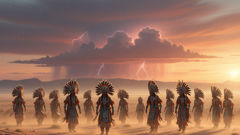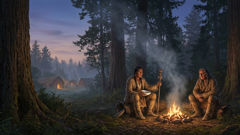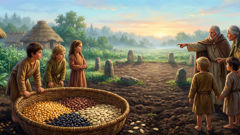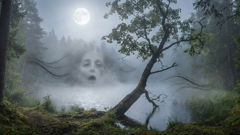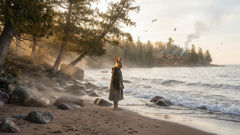Introduction
On the ragged edge of the map where the sea freezes into something like memory, people have told of beings that run faster than wind over packed snow, of creatures whose heads lift into human understanding and whose legs stay bone and fur. The Adlet sits in that uneasy place between human speech and animal hunger, a figure braided into stories told by families gathered around oil lamps and by children who tiptoe when dogs growl beyond the sod house. This is not a single tale but a family of tales—different names and details in different camps, a dozen ways of explaining a sudden cold, a missing seal, or a late traveler who stops answering. In some versions a woman bears a brood of half-dog children to a human husband; in others a spirit father gives rise to a pack of running men who thunder across tundra and ice. Their lower half is a dog’s: thick haunches, powerful paws, fur like the wind-pushed drifts. Their upper half is human: shoulders that carry grief, arms that gesture when they speak, faces that can smile and scheme. They are admired for speed, feared for aggression, and held at a wary respect as neighbors who might be kin or threat. Around these stories sit the concrete things that make them sensible—the long nights, the knife-edge scarcity of meat, the way sled dogs are both companion and commodity. My aim here is to trace the Adlet through geography and culture, to bring forward versions that elders still recount, to consider their symbolism and the ways the arctic environment shaped fears and hopes. I want to show how the Adlet functions as both mirror and warning: a mirror reflecting human traits magnified—hunger, cunning, the need to run—and a warning about the boundaries between species, between family and outsider, between survival and transgression. The telling that follows blends careful research with the cadence of oral tradition, honoring the voices of Inuit storytellers, while attending to the landscapes and seasons that gave the Adlet form. Read this as a long listen: to the wind over floes, to the creak of a seal boat, to the whisper of moccasins on frozen ground, and to the old, resilient stories that remain as weather is changed but the need to make meaning of danger remains the same.
Origins and Variations: Mapping the Adlet Across the Arctic
The Adlet appears across a chain of communities rather than a single village, each teller adding a strand that widens the braid. In one telling, recorded by an elder near Hudson Bay, a woman marries a man from the south and later, unable to feed herself, takes a lover who is part spirit-dog. The children born from that union run on dog legs. In another, told by a fisher on Baffin Island, the Adlet is a consequence of transgression: a woman punished or transformed for a relationship with an outsider or a supernatural being. Place names, seasonal cues, and the presence of sled dog culture shape how each community shapes the figure. Understanding the Adlet means attending to details that anthropologists and storytellers often treat as incidental: the type of dog common to a region, local hunting cycles, the cadence of winter storms. Where large, powerful sled dogs are prized, Adlet are imagined fast and enduring; where smaller, wiry dogs keep households, the Adlet takes on a leaner, more furtive aspect.
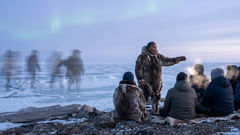
Across accounts the architecture of explanation is similar: a boundary crossed, a union between the familiar and the other, consequences that ripple into future generations. These are not mere horror stories but social maps—guides for what is allowed and for the costs of stepping outside kinship obligations. When a story says a woman bore dog-legs, listeners hear more than a monstrous detail; they hear the memory of alliances where obligations failed, of families beset by hunger or divided by marriages to outsiders, of children raised at the edge of acceptance. The Adlet functions as both mythic memory and social commentary.
Linguistic shifts complicate the picture. The word used for Adlet varies with dialect, and in translation subtleties slip away. Some names emphasize the dog; others emphasize speed or savagery. Early ethnographers sometimes flattened these differences into a single category, but contemporary Inuit scholars restore the multiplicity. Oral storytellers will correct a pronunciation, add a seasonal reference, or point out that a particular Adlet tale is told at the time when sleds are repaired in spring, when hunger and abundance are close relatives. These cues are vital: a story told in spring about a running Adlet may resonate as warning about traveling thin ice after the melt or about men who disappear during seal migrations.
The motif of the half-animal, half-human figure is hardly unique to the Arctic, but the Adlet is shaped by the land’s demands. Arctic winters cultivate particular fears: sudden blizzards that erase tracks, the sound of ice shifting like distant timber, the way scent carries—or is scrubbed—by cold. Dogs are central to survival here; they are partners in transport and hunting, sources of warmth, and sometimes prey in desperate seasons. The Adlet compresses these relationships into a being who is both helper and predator. In some stories Adlet steal away children who stray from the camp at night; in others they race with hunters, outrunning them, marking a painful lesson about hubris and overreach.
Many modern tellings add layers of interaction with colonial history. As trade networks and persistent outsiders entered Arctic regions, stories adapted. Some versions blame contact with sailors or traders for bringing illnesses and social disruptions that left families fragmented. The Adlet story, in those contexts, becomes a mythic locus for negotiating change: an expression of how communities grapple with altered lifeways, new dependencies, and the erosion of traditional practices. Elders sometimes couch the story as a way to remind younger people about boundaries—about who to trust, how to keep dogs and people healthy, and how to remember ancestral laws.
The symbolic weight the Adlet carries makes it a flexible figure in the hands of storytellers. Poets and artists rediscover Adlet as emblematic of liminality: between human and animal, land and sea, tradition and modernity. When an artist paints the Adlet under the aurora, they layer the visual language of movement with cultural memory. When a poet writes of a woman who weeps and breeds dog-children, they are not only invoking fear but mourning loss: of hearth resources, of connection, of clear social roles. Yet the Adlet is not simply a cautionary shadow. Some stories credit them with exceptional speed in battle or describe them as guardians of certain places. That ambivalence—dangerous but sometimes protective, repellant but kin-adjacent—reveals how a myth can hold contradictory feelings a community might have about the same source: dogs that must be harnessed, fed, and sometimes culled; neighbors who may aid in a crisis or who might take what is not theirs when desperation arrives.
The material evidence of these stories is often overlooked. There are artifacts—carvings, amulets, and prints—that echo the Adlet’s hybrid anatomy. Items used in ceremonial settings might reference dog motifs, and images of running canine bodies with raised human arms appear in some older carvings. These objects are not literal depictions of belief but visual companions to narrative, condensing a long-lived imagination into an object that can travel, be traded, or be held in a hand during a telling. Modern museums care for these items, debate provenance, and sometimes misinterpret context. Collaboration with communities has begun to yield more accurate readings, showing how visual and oral traditions entwine around the Adlet.
Finally, the Adlet’s place in the modern imagination reveals the power of myth to endure. Teachers in northern schools sometimes use the story to discuss respect for animals and the environment. Filmmakers find in the Adlet a striking visual for the uncanny Arctic night. But the most lasting aspect remains the story told to a child who wakes, hears teeth on the wind, and counts dogs at the edge of the camp. Myths endure because they help people live with uncertainty. The Adlet keeps its pace: a beat of warning and wonder across the snow, always moving, always near enough to be palpably remembered.
Stories, Symbolism, and Survival: The Adlet as Cultural Mirror
When a culture places dogs at the center of its mobility and memory, stories that hybridize human and canine unsurprisingly surface. The Adlet functions as a mirror, reflecting anxieties about survival, social cohesion, and the moral order of the camp. To read Adlet stories closely is to listen to the unsaid pressures of Arctic life: the scarcity that presses on relationships, the necessity of shared labor, and the silent calculus around feeding oneself and one’s kin. This section examines recurring motifs—speed, hunger, boundary—and explores how they act as moral and ecological reasoning for communities shaped by winter’s long negotiation.
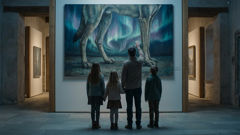
Speed is the Adlet’s most obvious trait. Tales emphasize their startling swiftness: an Adlet will chase a seal across ice, overtake a dog team, or disappear into the horizon before a hunter can raise his harpoon. Speed is both practical and symbolic. Practically, the Arctic rewards and punishes fast responses—an animal detected too late is a lost meal, a misstep on thin ice can be fatal. Symbolically, speed implies separation: the Adlet’s ability to outrun humans suggests a being that can't be integrated into normal social rhythms. This separation is morally charged. A running figure beyond recall becomes an emblem of someone cut off from reciprocal obligations. Where community life depends on sharing resources, a runaway that takes without returning triggers stories meant to explain and to caution.
Hunger is another recurring motif. The Adlet’s appetite is multi-layered: literal, social, and spiritual. In literal terms, an Adlet needs meat like any predator. But the stories often make hunger stand in for social starvation: damaged kin networks that no longer provide for vulnerable members, the breakdown of ritual sharing, or the quiet erosion of reciprocity when trade goods replace traditional exchanges. An Adlet that steals a child or a cache of meat is a narrative shorthand for the consequences of neglecting communal duties. At the spiritual level, hunger can suggest an appetite that cannot be sated—an insatiable otherness that threatens balance. Many narrators will pause at this point, their tone shifting from talecraft to admonition, reminding listeners that hunger unattended breeds transformations.
Boundaries—between inside and outside, human and animal, consent and coercion—thread through most Adlet accounts. The repeated image of the half-human figure walking or running along the camp’s edge is no accident. Camps are nodes of warmth and obligation; the edge is where rules blur. An Adlet at the perimeter sets a boundary marker in story form: here lies the limit of hospitality, beyond which lies danger. Some stories put the boundary directly into family law: marrying outside kin in reckless ways will produce dog-children; abandoning obligations produces outsiders who cannot be trusted with human relationships. These narratives are not simply conservative strictures. They are survival strategies articulated through story—ways to teach the young about the actual stakes of social choices in environments that offer little margin for error.
There is also a gendered structure to many Adlet tales. Women often occupy central roles: as mothers of Adlet, as the keepers of domestic resources, and as moral actors who either uphold or transgress social mores. That the Adlet’s genesis sometimes involves intimate relations with outsiders signals anxieties around marriage choices and the social consequences of mixing groups. Yet some stories invert this expectation, giving women agency in creative ways—choosing cross-species marriage to secure survival, or outwitting Adlet to protect family. These inversions show the narratives are not static; they evolve to accommodate changing power relations and lived realities.
Ecology enters story in concrete technologies and landscapes: the sound of a sled runner on ice, the print of a paw next to a human footprint, the particular tracks left by a heavy-furred hind leg. Elders teaching hunters can point to a track and say, half-jokingly, that an Adlet has been through—blending cautionary tale with practical knowledge. Snow and ice are characters too, propelling action with sudden melt, cracking floes, and wind-sculpted drifts that can hide a path. The Adlet’s form—human torso for tool use and canine legs for movement—speaks to a life optimized both for carrying tools and sustaining pace across miles of frozen sea. The hybridity, then, reads like a mythic commentary on innovation: when climate and subsistence demand speed and endurance, stories imagine bodies that answer.
When outsiders—traders, missionaries, researchers—entered Arctic regions, they influenced the way Adlet stories circulated. Missionary accounts often moralized the tales, framing them as remnants of pagan belief to be corrected. Early ethnographic records sometimes exoticized the Adlet, emphasizing horror elements attractive to southern audiences. Contemporary scholars and Indigenous storytellers push back, emphasizing contextual complexity and the stories’ ongoing relevance. That reclamation has produced new forms: Adlet-inspired songs, contemporary short fiction, and community-driven exhibits where elders narrate not for outsiders but for younger generations, ensuring the tale retains its functional wisdom.
Within contemporary practice, the Adlet can also be a figure of resilience. Artists reclaim its imagery to speak of endurance and adaptability: the dog-legs that keep moving despite weather become an image for cultural survival. In these hands Adlet shifts from menace to metaphor; the creature’s speed is a quality to emulate—not in outrunning obligations but in maintaining cultural movement, keeping stories alive across generations and shifting conditions. For educators, the Adlet story becomes a bridge: a way to teach ecological knowledge, the ethics of sharing, and respect for animals while honoring tradition.
Finally, the Adlet refracts questions about kinship in a changing world. As Arctic communities negotiate modern pressures—climate change, resource extraction, and sociocultural shifts—mythic figures like the Adlet retain their instructive function. They remind communities of the costs of losing reciprocity, of forgetting elder wisdom, and of confusing market logic with kinship obligations. They also offer a vocabulary for imagining hybrid futures: beings that bridge forms, communities that must invent new social practices to withstand new seasons. The Adlet’s story thus remains a living instrument, used to think through survival and social ethics as much as to thrill and frighten listeners.
Conclusion
The Adlet remains a durable example of how myth responds to place. Born of cold and dogs and the social tensions they magnify, the Adlet speaks in swift, dangerous cadences that both alarm and instruct. To tell this story is to listen for the ethical demands the Arctic imposes: share what you have, honor obligations, and respect the fragile margins between inside and outside. But the Adlet also embodies a different lesson: adaptability. Its hybrid form is not only a warning but also a testament to how beings—and stories—change to meet new conditions. As elders tell the tale to children now, with snowmobiles idling outside and satellites tracking the ice, the Adlet runs still, a figure braided into modern life. Respectful retellings keep the myth alive by centering Indigenous voices, by acknowledging the landscapes that birthed the story, and by holding the Adlet as both mirror and map: a creature who shows what happens when the social fabric frays, and who points toward ways a community might mend. That repair—like a dog team resetting its lines before a long run—depends on listening, remembering, and sharing the stories that keep people steady in weathered places.






